
September 5, 2023
Imagine a world where the very sand beneath your feat determines the fate of an entire species.
Sea turtles, ancient mariners of our oceans, have graced our planet for millions of years. Yet today, they face a precarious future. Six of the seven known sea turtle species are on the brink of extinction. A significant factor in their survival hinges on the delicate conditions under which their eggs incubate.
Dive into the intricate dance of temperature, sand, and survival.
Like their reptilian cousins, sea turtles lay eggs. But for these marine creatures, the incubation environment isn’t just about survival: it’s also about identity.
The temperature at which these eggs develop determines not only the hatching rate, it can also determine the gender of the hatchlings, a phenomenon known as temperature-dependent sex determination. For sea turtle eggs, temperature isn’t merely about warmth; it’s a gender switch.
A few degrees can tilt the balance between male and female hatchlings. But what factors influence this crucial temperature?
The sand enveloping a sea turtle’s nest functions similarly to a thermal insulator, much like a blanket that retains warmth during a chilly night, this is known as ‘thermal conductivity.’ In essence, thermal conductivity is a measure of a material’s capability to conduct and transfer heat. When a substance, like sand, exhibits high thermal conductivity, it signifies its proficiency in rapidly transmitting heat. This swift heat transfer can lead to a potential increase in the nest’s internal temperature.
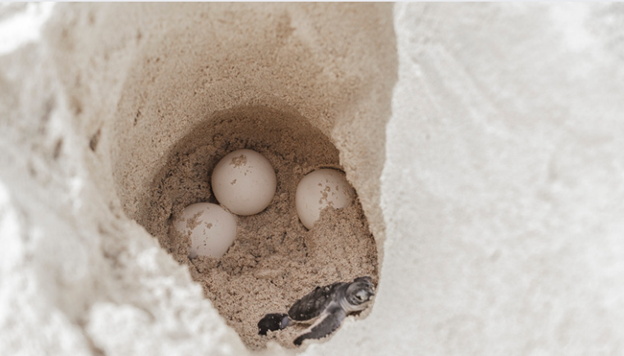
Figure 2. Sea turtle nest with eggs and a new hatchling
However, another crucial property of sand is its low specific heat. This means that sand doesn’t require a significant amount of energy from the sun to become warm. In addition, the inherent density of sand enables it to accumulate and store vast quantities of thermal energy. Simply put, the sun’s rays can swiftly elevate the surrounding sand’s temperature, affecting the nest’s temperature. Moreover, the dense nature of the sand ensures that this acquired heat is retained for extended duration, providing consistent warmth to the nest.
Our team of scientists has delved deeper into understanding the thermal properties of sand. They’ve conducted a comprehensive study on the thermal effusivity of sand, which further sheds light on how sand interacts with and transfers heat. For a more detailed insight into their findings, refer to the study here: Thermal effusivity of sand.
As global temperatures rise, the consequences of climate change are becoming increasingly evident, especially in delicate ecosystems. One such ecosystem is the sea turtle nesting beach.
Research has shown that warming incubation temperatures often lead to the birth of female hatchlings, while cooler temperatures produce males. This phenomenon, known as temperature-dependent sex determination, is crucial for the survival of sea turtle populations. With the current trajectory of global warming, many nesting beaches are experiencing higher than average temperatures. This shift results in a skewed gender ratio, with more female hatchings than males.
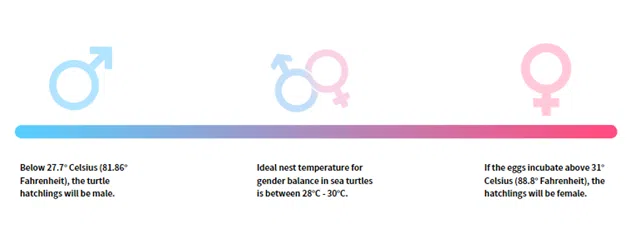
Figure 3. Temperature dependent sex determination in sea turtles.
At first glance, an increase in the female population is advantageous for a species that relies on a single female laying hundreds of eggs in her lifetime. However, an imbalance between male and female populations can spell trouble for future generations. A disproportionate gender ratio can lead to reduced genetic diversity, increased competition for mates, and ultimately challenges in sustaining the population.
Recognizing the looming threat to sea turtles, conservationists worldwide are taking proactive measures. They understand that the survival of these marine creatures is intricately linked to the health of our oceans and, by extension, the planet.
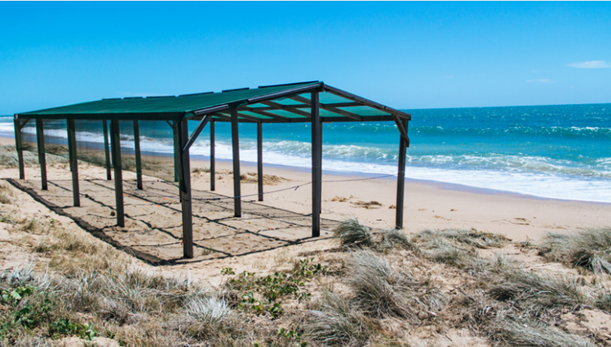
Figure 4. Example of artificial shade being used on an Australian beach.
1. Shading Nests: One of the immediate strategies employed is the shading of nests. Conservationists can effectively lower the sand temperature by using natural or artificial structures to cast shadows over the nesting sites, ensuring a more balanced gender ratio upon hatching.
2. Relocating Nests: In areas where beaches consistently record higher temperatures, nests are relocated to cooler locales. This not only ensures a balanced gender ratio but also increases the eggs’ chances of survival, as extremely high temperatures can be lethal for the developing embryos.
3. Beach Nourishment: As we’ve learned, the type of sand can influence the temperature of the nests. Beach nourishment involves adding coarser and darker sand, which can sometimes increase temperatures. However, by carefully selecting and using lighter-coloured sand, it’s possible to counteract the warming effect to some extent.
4. Public Awareness: Conservationists are also focusing on public awareness campaigns, educating locals and tourists about the importance of not disturbing nesting sites, reducing beachfront lighting during nesting season, and minimizing beach activities that can impact the temperature of the sand.
5. Research and Monitoring: Researchers continuously monitor nesting site temperatures and strive to understand how climate change affects sea turtle populations in the long term. This research is crucial in adapting and evolving conservation strategies.
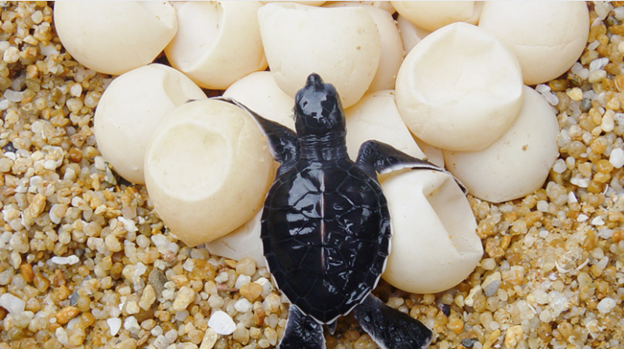
Figure 5. Newly hatched sea turtle.
The fight for sea turtle survival is indeed in full swing. With combined efforts from communities, governments, and conservationists, there’s hope that these ancient creatures will continue to grace our oceans for generations to come.
Understanding the thermal conductivity of sand is crucial, as it directly affects the development and survival of sea turtle embryos. Researchers have found that variations in sand composition and moisture content can significantly impact heat transfer within the nest, potentially influencing hatchling sex ratios and overall reproductive success.
The intricate relationship between sea turtles and their nesting environment has been a subject of interest for many researchers. Recent studies have taken this exploration a step further by examining the thermal properties of the sand in which these turtles lay their eggs. Sand’s thermal conductivity, which refers to its ability to conduct heat, plays a pivotal role in determining the incubation temperature of sea turtle eggs.
1. Nourished Beaches and Thermal Properties: Research has shown that beach nourishment, a practice used to protect coastal areas, can inadvertently alter a beach’s thermal properties. Nourished sections of beaches are, on average, 0.4°C warmer than their unnourished counterparts. The type of sand used, especially if it’s coarser and darker, can exacerbate the warming effect, potentially impacting the gender ratio of hatchling.
2. Duration at High Temperatures: It’s not just the temperature itself but the duration at that temperature that dictates hatching success. For instance, while loggerhead turtle nests can withstand temperatures up to 35.4°C, prolonged exposure to such temperatures, especially during the latter part of incubation, can drastically reduce hatching success.
These findings illuminate new pathways for conservation. By understanding the specific thermal properties that affect sea turtle egg incubation, conservationists can make more informed decisions about beach nourishment projects, sand selection, and nest relocation strategies.
The revelations about thermal conductivity and its influence on sea turtle reproduction are more than just academic findings; they guide future conservation efforts. By delving deep into the science of sand and temperature, we can tailor conservation strategies to ensure optimal conditions for sea turtle nests.
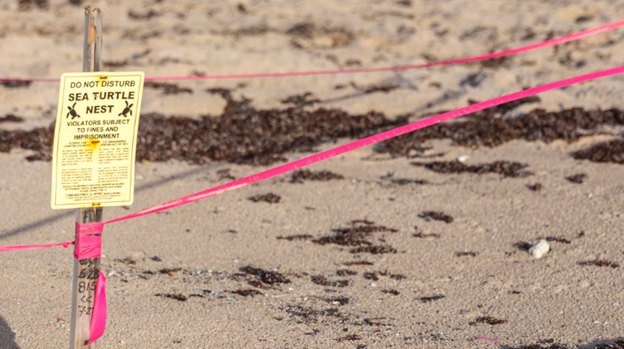
Figure 6. In Fort Lauderdale, Florida, sea turtle nests are blocked off and protected.
1. Tailored Nest Relocation: Knowing how different sand types affect incubation temperatures, nests can be relocated to sand areas, promoting balanced gender ratios and higher hatching success rates.
2. Innovative Cooling Techniques: Beyond shading, researchers are exploring innovative cooling techniques, such as using artificial materials that reflect sunlight or introducing moisture to control sand temperature.
3. Community Engagement: Engaging coastal communities in conservation efforts is crucial. By educating them about the importance of sand’s thermal properties, communities can actively select appropriate sites for beach nourishment and protecting natural nesting areas.
4. Policy and Regulation: This newfound knowledge can also influence policy decisions, guiding regulations on beachfront development, lighting, and human activities that can alter sand’s thermal properties.
Armed with this knowledge, conservationists, communities, and policymakers are better equipped to navigate the challenges of a warming world. The science of thermal conductivity is our beacon, illuminating the path forward as we strive to ensure the survival of sea turtles for generations to come.
The intricate ballet of sea turtle reproduction is a testament to nature’s wonders. As we grapple with a changing climate, understanding the role of thermal conductivity becomes paramount. With knowledge and passion, we can chart a course towards a brighter future for these marine marvels. Read more on sea turtles and climate change.
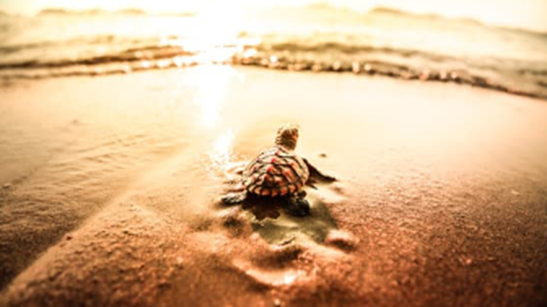
Figure 7. Newborn sea turtle making its way into the ocean.
1. How does temperature decide the gender of sea turtle hatchling?
Sea turtles exhibit a unique reproductive phenomenon known as temperature-dependent sex determination (TSD). The gender of the hatchling is determined by the temperature of the sand surrounding the nest during a critical period of embryo development. Nests that experience warmer temperatures predominantly produce female hatchling, while those subjected to cooler temperatures tend to yield male hatchling.
2. What exactly is thermal conductivity?
Thermal conductivity is a measure of a material’s ability to conduct and transfer heat. In the context of sand and sea turtle nests, it refers to how efficiently sand can absorb, store, and transmit heat from the sun or surrounding environment. A high thermal conductivity means the sand can quickly transfer heat, potentially influencing the internal temperature of a sea turtle’s nest.
3. How is climate change shaking up the sea turtle world?
Climate change, particularly global warming, is causing a rise in average temperatures worldwide. For sea turtles, this means that the sand surrounding their nests is getting warmer. As a result, there’s a higher likelihood of producing more female hatchling due to the temperature-dependent sex determination. Over time, this can lead to a skewed gender ratio, potentially threatening the long-term survival of sea turtle populations.
4. Are there ways to shield sea turtle nests from the heat?
Absolutely! Conservationists and researchers have been exploring various methods to protect sea turtle nests from excessive heat. Some of these strategies include:
• Shading: Using natural or artificial materials to shade nests, thereby reducing direct exposure to sunlight and heat.
• Relocation: Moving nests to cooler, shaded areas or even to beaches with naturally cooler sands.
• Watering: Sprinkling water on the sand can help reduce its temperature, especially during peak heat periods.
5. Why is sand’s thermal conductivity so crucial for sea turtle eggs?
The thermal conductivity of sand plays a pivotal role in determining the temperature inside a sea turtle’s nest. Since the gender of sea turtle hatchling is influenced by nest temperature, the sand’s ability to conduct heat directly impacts the gender ratio of the hatchling. Moreover, extreme temperatures, either too high or too low, can be detrimental to the overall development and survival of the eggs.
Shamblott, K. M., Reneker, J. L., & Kamel, S. (2021). The Thermal Impacts of Beach Nourishment Across a Regionally Important Loggerhead Sea Turtle Rookery Ecosphere, 12(3).
Kobayashi, S., Aokura, N., Fujimoto, R.,… & others (2018). Incubation and water temperatures influence the performance of loggerhead sea turtle hatchlings during the dispersal phase. Scientific Reports, 8(1)
Howard, R., Bell, I., & Pike, D. (2014). Thermal Tolerances of Sea Turtle Embryos: Current Understanding and Future Directions Endangered Species Research, 26, 75-86
Speakman, J.R., Hays, C.G., and Lindbad, E. 1998. The thermal conductivity of sand and its effect on the temperature of loggerhead sea turtle (Caretta caretta) nests. J. Mar. Bioi. Ass. U.K. 78: 1–16.
Greely, T. (2008). Ocean Literacy and Reasoning About Ocean Issues: The Influence of Content, Experience, and Morality https://core.ac.uk/download/154465864.pdf
Sea Turtle Conservancy (n.d.) Why are sea turtles so important? Retrieved from http://www.seaturtle.org/faq/answers/59.shtml
Sea Turtle Conservancy (n.d.) Sea Turtle Behaviour Retrieved from http://www.conserveturtles.org/seaturtleinformation.php?page=behaviour